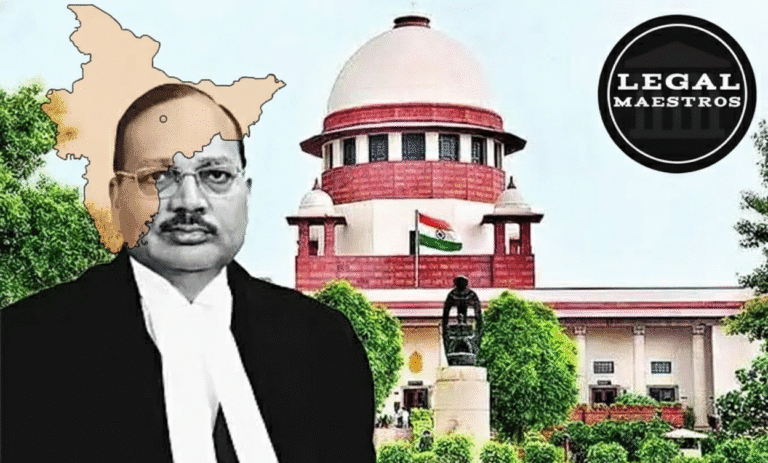
This paper presents a landmark ruling by the Supreme Court of India on the acquisition of land and the unjust compensation to the farmers. The basic question that arises in this case, which was represented by Manohar and others after appealing against the State of Maharashtra, is that whether the market value of acquired land is to be decided or not especially when several sale deeds are submitted in evidence. Not only does the ruling of the Supreme Court rectify a mistake on behalf of the inferior courts, such ruling also validates a longstanding rule of law in reference to practices concerning the utilization of the so called highest exemplars implement.
Background of the Case
The appeals were a consequence of shared judgment and final order delivered April 21, 2022, by High Court of Judicature at Bombay, Bench at Aurangabad, which had itself dismissed appeals by claimants, who were farmers. This was a case of obtaining land in the 1990s, under the Maharashtra Industrial Development Act, 1961, in order to set up an industrial area at the outskirts of Jintur town in Parbhani District, Maharashtra. The farmers who are the appellants owned land which was acquired to undertake this project.
Land Acquisition Officer first gave compensation of Rs. 10,800 per acre. The farmers were not satisfied with this figure and they accepted the payment reluctantly and in 1997 filed a reference under Section 18 of the Land Acquisition Act, 1894. In its June 7, 2007 decision, the Reference Court granted the reference in part and increased the compensation to Rs. 32 000 per acre dry land and Rs. 40,000 per acre irrigated land (interest included). Nevertheless, the farmers still felt aggrieved and made a First Appeal to the High Court which was also dismissed. This has prompted the farmers to make the current appeals through special leave to the Supreme Court.
For any queries or to publish an article or post or advertisement on our platform, do call at +91 6377460764 or email us at contact@legalmaestros.com.
The Rhetoric of Organization: The Land as Valued
The main question arising in the supreme court was, was the decision made by the High court, which maintained the judgment given by the Reference Court, sustainable? The farmers believed that the lower courts had not given due prominence to the greatest sale model that could be used as evidence. The lands they purchased were in a good place with non agricultural potentialities along with water amenities in close proximity to Jintur town and Nashik-Nirmal State Highway.
In an attempt to help them claim higher compensation, the appellants had lined ten instances of sales before the Reference Court. It is interesting to note that there was sale exemplar number 4 which was a Jintur sale which was located on March 31, 1990 and it had a market value of 72,900 per acre. This was the nearest sale preceding the date of the notice of acquisition of land in the 19 th July 1990. Although the Reference Court first believed that all the posted instances of sales could be trusted, it surprisingly missed out the greatest value transaction at sliding number 4. Rather, it used an average of remaining other sale deeds that were sold at an average of Rs. 40,000 per acre. The High Court made a contradictory ruling, on the one side recognizing that the highest exemplar was not taken into account by Reference Court, on the other side ruling that it was considered.
The Analysis and Decision of Supreme Court
The Supreme Court upheld the conclusion of the High Court as being fallacious by saying that indeed, the Reference Court overlooked the highest exemplar while giving no reasons. The court has laid stress that when there has been a series of exemplars relating to similar land then the most eligible one to be considered is the highest, which having realized a deal in good faith must be taken into account. The court also explained that averaging can only be used when there has been a sale of a number of similar plots of lands within a certain range of differences but that was not in this case since the sale of the prices varied as low as Rs. 25,000 and as high as Rs. 72,900 per acre.
For any queries or to publish an article or post or advertisement on our platform, do call at +91 6377460764 or email us at contact@legalmaestros.com.
Even the idea that the utmost exemplar was “abnormally high value,” was declined by the Supreme Court as well, because there was a non-agricultural goodwill and ideal site of the land that was bought. It also observed that the sale exemplars of the years 1992 and 1993 that depicted the value of Rs.61,500 and Rs.60,000/- per acre were nearer to the highest value exemplar than to the value of the other exemplars as considered by the Reference Court.
On the analysis, the Supreme Court ruled in favor of the farmers to receive the benefit of the highest sale exemplar. Nevertheless, given that the points of sale examples were small plots and since the land that was being purchased was a large piece of land the Court maintained the deduction done by the Reference Court of 20 per cent of the development costs.
The high court judgment and the Reference court judgment were overturned by the Supreme court. It ordered that the compensation amount of the appellants be increased to Rs. 32,000 per acre to be raised to Rs. 58,320 per acre. The highest exemplar figure of Rs. 72,900 per acre was brought down to a final figure by allowing a 20 per cent deduction amounting to Rs. 14,580 per acre totaling to Rs. 57,320 per acre. The court further ordered that all the consequential statutory benefits should be awarded to the appellants which would include solatium and interest attached to the increased compensation.
For any queries or to publish an article or post or advertisement on our platform, do call at +91 6377460764 or email us at contact@legalmaestros.com.




![Research Assistantship @ Sahibnoor Singh Sindhu, [Remote; Stipend of Rs. 7.5k; Dec 2025 & Jan 2026]: Apply by Nov 14, 2025!](https://legalmaestros.com/wp-content/uploads/2025/11/Gemini_Generated_Image_s0k4u6s0k4u6s0k4-768x707.png)
![Karanjawala & Co Hiring Freshers for Legal Counsel [Immediate Joining; Full Time Position in Delhi]: Apply Now!](https://legalmaestros.com/wp-content/uploads/2025/11/Gemini_Generated_Image_52f8mg52f8mg52f8-768x711.png)
![Part-Time Legal Associate / Legal Intern @ Juris at Work [Remote]: Apply Now!](https://legalmaestros.com/wp-content/uploads/2025/11/ChatGPT-Image-Nov-12-2025-08_08_41-PM-768x768.png)
![JOB POST: Legal Content Manager at Lawctopus [3-7 Years PQE; Salary Upto Rs. 70k; Remote]: Rolling Applications!](https://legalmaestros.com/wp-content/uploads/2025/11/ChatGPT-Image-Nov-12-2025-08_01_56-PM-768x768.png)